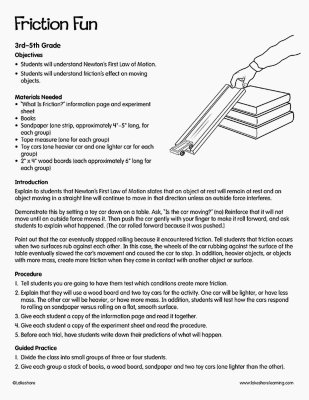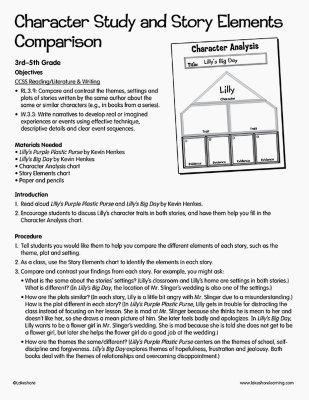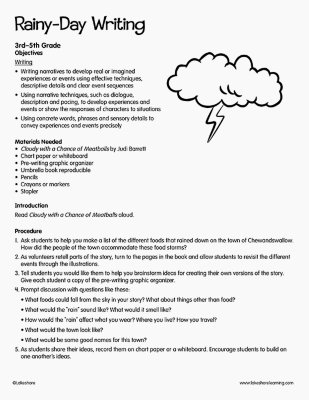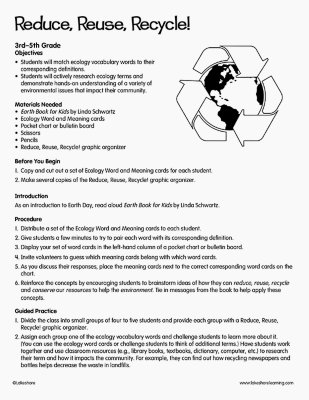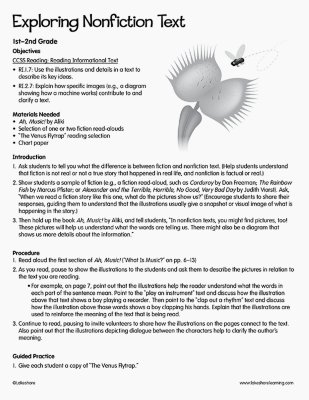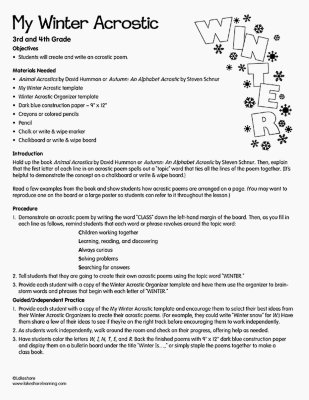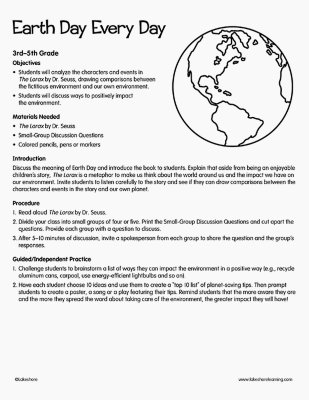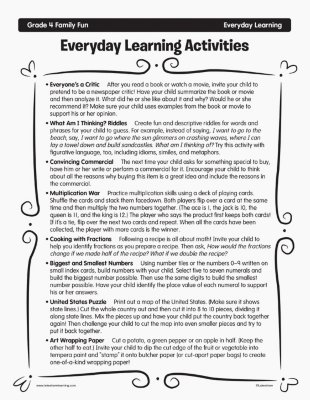Narrow by Grade
- Infant (2)
- Toddler (5)
- Preschool (0)
- Pre-K (13)
- Kindergarten (11)
- 1st (11)
- 2nd (6)
- 3rd (8)
- 4th (9)
- 5th (5)
- 6th & Up (0)
Grade 4th
Narrow by Age
- 0-18m (0)
- 18-36m (0)
- 3 yrs. (0)
- 4 yrs. (0)
- 5 yrs. (0)
- 6 yrs. (0)
- 7 yrs. (0)
- 8 yrs. (5)
- 9 yrs. (9)
- 10 yrs. (3)
- 11 yrs. & Up (0)
Age
9 results for "books"
Filters
Clear All
Friction Fun
4th Grade
Objectives Students will understand Newton’s First Law of Motion. Students will understand friction’s effect on moving objects. Materials Needed “What Is Friction?” information page and experiment sheet Books Sandpaper (one strip, approximately 4" - 5" long, for each group) Tape measure (one for each group) Toy cars (one heavier car and one lighter car for each group) 2" x 4" wood boards (each approximately 6" long for each group) Introduction Explain to students that Newton’s First Law of Motion states that an object at rest will remain at rest and an object moving in a straight line will continue to move in that direction unless an outside force interferes. Demonstrate this by setting a toy car down on a table. Ask, “Is the car moving?” (no) Reinforce that it will not move until an outside force moves it. Then push the car gently with your finger to make it roll forward, and ask students to explain what happened. (The car rolled forward because it was pushed.) Point out that the car eventually stopped rolling because it encountered friction. Tell students that friction occurs when two surfaces rub against each other. In this case, the wheels of the car rubbing against the surface of the table eventually slowed the car’s movement and caused the car to stop. In addition, heavier objects, or objects with more mass, create more friction when they come in contact with another object or surface.
View Lesson PlanCharacter Study and Story Elements Comparison
3rd Grade - 4th Grade
Objectives CCSS Reading/Literature & Writing RL.3.9: Compare and contrast the themes, settings and plots of stories written by the same author about the same or similar characters (e.g., in books from a series). W.3.3: Write narratives to develop real or imagined experiences or events using effective technique, descriptive details and clear event sequences. Materials Needed Lilly’s Purple Plastic Purse by Kevin Henkes Lilly’s Big Day by Kevin Henkes Character Analysis chart Story Elements chart Paper and pencils Introduction Read aloud Lilly’s Purple Plastic Purse and Lilly’s Big Day by Kevin Henkes. Encourage students to discuss Lilly’s character traits in both stories, and have them help you fill in the Character Analysis chart.
View Lesson PlanCause and Effect
3rd Grade - 4th Grade
Objective CCSS Reading: Informational Text RI.3.3: Describe the relationship between a series of historical events, scientific ideas or concepts, or steps in technical procedures in a text, using language that pertains to time, sequence, and cause/effect. Materials Needed “The Earthquake that Changed Earth” nonfiction reading selection “The Earthquake that Changed Earth” graphic organizer and sample graphic organizer Cause & Effect Flip Book template Scissors Pencils or markers A copy of any other nonfiction text
View Lesson PlanRainy-Day Writing
3rd Grade - 5th Grade
Objectives Writing Writing narratives to develop real or imagined experiences or events using effective techniques, descriptive details and clear event sequences Using narrative techniques, such as dialogue, description and pacing, to develop experiences and events or show the responses of characters to situations Using concrete words, phrases and sensory details to convey experiences and events precisely Materials Needed Cloudy with a Chance of Meatballs by Judi Barrett Chart paper or whiteboard Pre-writing graphic organizer Umbrella book reproducible Pencils Crayons or markers Stapler Introduction Read Cloudy with a Chance of Meatballs aloud.
View Lesson PlanReduce, Reuse, Recycle!
4th Grade
Objectives Students will match ecology vocabulary words to their corresponding definitions. Students will actively research ecology terms and demonstrate hands-on understanding of a variety of environmental issues that impact their community. Materials Needed Earth Book for Kids by Linda Schwartz Ecology Word and Meaning cards Pocket chart or bulletin board Scissors Pencils Reduce, Reuse, Recycle! graphic organizer Before You Begin Copy and cut out a set of Ecology Word and Meaning cards for each student. Make several copies of the Reduce, Reuse, Recycle! graphic organizer. Introduction As an introduction to Earth Day, read aloud Earth Book for Kids by Linda Schwartz.
View Lesson PlanExploring Nonfiction Text
4th Grade
Objectives CCSS Reading: Reading Informational Text RI.1.7: Use the illustrations and details in a text to describe its key ideas. RI.2.7: Explain how specific images (e.g., a diagram showing how a machine works) contribute to and clarify a text. Materials Needed Ah, Music! by Aliki Selection of one or two fiction read-alouds “The Venus Flytrap” reading selection Chart paper Introduction Ask students to tell you what the difference is between fiction and nonfiction text. (Help students understand that fiction is not real or not a true story that happened in real life, and nonfiction is factual or real.) Show students a sample of fiction (e.g., a fiction read-aloud, such as Corduroy by Don Freeman; The Rainbow Fish by Marcus Pfister; or Alexander and the Terrible, Horrible, No Good, Very Bad Day by Judith Viorst). Ask, “When we read a fiction story like this one, what do the pictures show us?” (Encourage students to share their responses, guiding them to understand that the illustrations usually give a snapshot or visual image of what is happening in the story.) Then hold up the book Ah, Music! by Aliki, and tell students, “In nonfiction texts, you might find pictures, too! These pictures will help us understand what the words are telling us. There might also be a diagram that shows us more details about the information.”
View Lesson PlanMy Winter Acrostic
3rd Grade - 5th Grade
Objectives Reading: Literature Reading and comprehending grade-appropriate literature, including stories, dramas, and poetry Writing Writing an acrostic poem Materials Needed Animal Acrostics by David Hummon or Autumn: An Alphabet Acrostic by Steven Schnur My Winter Acrostic template Winter Acrostic Organizer template Dark-blue construction paper - 9" x 12" Crayons or colored pencils Pencil Chalk or write & wipe marker Chalkboard or write & wipe board Introduction Hold up the book Animal Acrostics by David Hummon or Autumn: An Alphabet Acrostic by Steven Schnur. Then explain that the first letter of each line in an acrostic poem spells out a “topic” word that ties all the lines of the poem together. (It’s helpful to demonstrate the concept on a chalkboard or write & wipe board.) Read a few examples from the book and show students how acrostic poems are arranged on a page. (You may want to reproduce one on the board or a large poster so students can refer to it throughout the lesson.)
View Lesson PlanEarth Day Every Day
3rd Grade - 5th Grade
Objectives Students will analyze the characters and events in The Lorax by Dr. Seuss, drawing comparisons between the fictitious environment and our own environment. Students will discuss ways to positively impact the environment. Materials Needed The Lorax by Dr. Seuss Small-Group Discussion Questions Colored pencils, pens or markers Introduction Discuss the meaning of Earth Day, and introduce the book to students. Explain that aside from being an enjoyable children’s story, The Lorax is a metaphor to make us think about the world around us and the impact we have on our environment. Invite students to listen carefully to the story and see if they can draw comparisons between the characters and events in the story and our own planet.
View Lesson PlanEveryday Learning Activities
4th Grade
Everyone’s a Critic After you read a book or watch a movie, invite your child to pretend to be a newspaper critic! Have your child summarize the book or movie and then analyze it. What did he or she like about it and why? Would he or she recommend it? Make sure your child uses examples from the book or movie to support his or her opinion.
View Lesson Plan